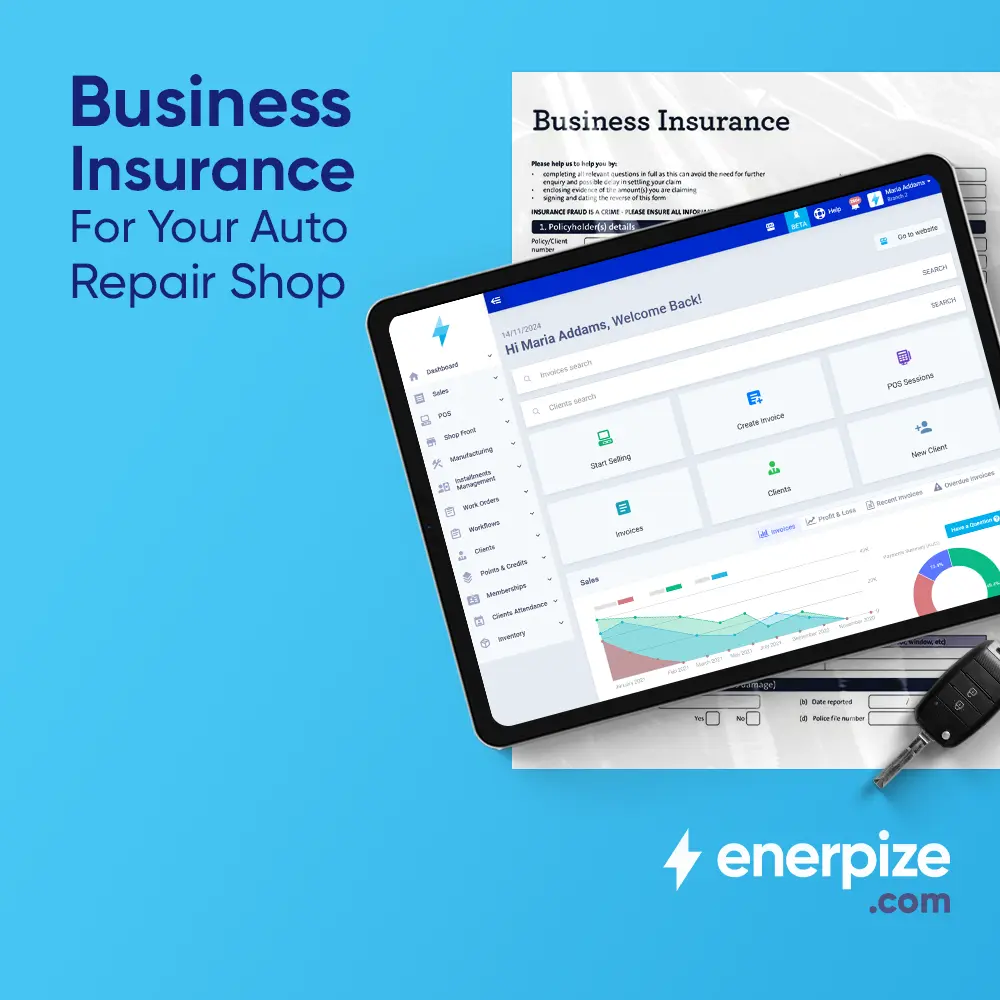Create and send online quotations and invoices, track sales, monitor staff performance, and sell & sync all your products via our POS and more.
Author : Enerpize Team
7 Ways to Accept Payments Online

The future is virtual. In-person banking services are becoming a legacy. The shift from conventional banking services to online services, including crypto offerings, is an industry shift and a massive demographic transformation at once informed by Generation Z’s banking and spending habits. Data is key to showing current shifts in banking services.
In 2024 alone, the global digital payment market reached a volume of USD 11.53 tn at an annual growth rate of 9.5%, with an overall volume projected at USD 16.59 tn by 2028. Unsurprisingly, digital commerce has the lion’s share of such growth at USD 7.62 tn in 2024.
This post enables you - as a business owner or executive manager - to understand seven ways to accept payments online:
- Credit & Debit Cards
- Payment Gateways
- Wire Transfers (Direct Debit)
- Mobile Payments
- Digital Wallets
- Cryptocurrencies
- Buy Now, Pay Later (BNPL)
Read on to understand how to put one or all seven online payment ways into a maximized benefit to your business.
Credit and Debit Cards
Credit and debit cards, taken for granted as classic payment methods, are early precursors of more sophisticated, virtualized, and automated services such as digital wallets and cryptos (explained in a bit).
A differentiation should, however, be made between each payment method.
Credit Cards
A credit card is ultimately a loan. Now in plastic or virtual form, credit cards have a long history dating back millennia to when merchants issued IOUs instead of paying in cash or in kind. That way of payment was - and still is - only one form of an agreement to buy now and pay later (explained in a bit).
You apply for a credit card at a banking institution, get risk assessed, and, based on your assessment report, be approved or not. If approved, you get a plastic card or, in recent practice, a virtual card.
Banking or financial institutions such as Visa, Mastercard, and American Express issue credit cards (aka card providers).
Debit Cards
Unlike credit cards, debit cards are not loans but monetary values deducted from a checking account. As such, debit cards are a plastic form of physical cash.
Pros of Credit & Debit Cards
The benefits of credit and debit cards have been evident to millions of users worldwide for decades now, including:
- Extremely secure (securely encrypted)
- Short processing cycles (monetary values are credited or debited instantly)
- Trusted (backed by heavily regulated banking and financial institutions)
Cons of Credit & Debit Cards
The downsides of credit and debit cards are also a matter of consideration. Common downsides include:
- Credit score broad impact: Exceeding credit limits may deny cardholders access to various services, such as applying for a mortgage, buying a car, etc.
- Limited access to credit of debit cards: Because debit cards are not loans and are only a way to access monetary values in a checking account, they are limited by what cardholders have in their bank accounts. That is why some online platforms and businesses do not accept debit cards as a precaution against possible fraud or collection issues.
- Card data integrity. In recent years, data breaches have made headlines. Despite military-grade encryptions, cardholder behavior is a prevalent reason card information is stolen and ransomed. Consider senior persons. The combination of old age, technology aversion, and generational differences - all contribute to incredibly easy data compromise and identity theft incidents.
Read Also: Explaining The POS Transaction on Bank Statement
Payment Gateways
Payment gateways are simply front-end interfaces collecting customer (payer) information for further processing by a payment processor. Payment gateways are middlemen between customers (payers) and merchants, facilitating fund transfers between payers and payees (merchants, for example).
As such, payment gateways are not financial institutions authorized to pay or debit funds from or to customers and merchants. Instead, payment gateways are simply “gates,” a layer in a series of financial transactions initiated by a customer at a physical point, such as POSs, or a virtual one, such as checkouts on e-commerce platforms.
The two most common examples of payment gateways are PayPal and Stripe, which millions of users use on supply (consumer) and demand (seller) ends.
Pros & Cons of Payment Gateways
While secure, fast, and antifraud-designed, payment gateways involve relatively high processing fees and integration complexities.
Wire Transfers (Direct Debit)
This is an established and classic payment method that has been used across many industries and by millions of account holders for decades. Wire transfers are interbank electronic transfers from one account to another, domestically or internationally. ACH (US) and SEPA (Europe) are typical providers.
Pros & Cons of Wire Transfers
As with every payment method, wire transfers have upsides and downsides. On the upside, wire transfers are:
- Secure
- Legitimate
- Cost-effective for recurring payments
On the downside, wire transfers are:
- Slow
- Expensive for one-time high-volume transactions
- Prone to money laundering practices in jurisdictions where tax regulations and financial controls are lax, a backdoor to legitimize shady or outright illegal financial transactions
Mobile Payments
A mobile payment is a virtual payment form using a mobile device such as a tablet, laptop, or mobile phone.
Interestingly, mobile payments became popular outside North America, specifically in Asia, and were later adopted widely in the US and Canada. This is partly explained by Asia’s, particularly China’s, explosive e-commerce growth.
Examples of mobile payments are too many to count, but some prevalent examples include:
- Apple Pay
- Google Pay
- Alipay
Pros & Cons of Mobile Payments
On the upside, mobile payments are secure, fast, and user-intuitive. On the downside, mobile payments come with a set of challenges including:
- Technical complexities. By default, mobile payments depend on mobile phones and are host-dependent, rendering phones useless in cases of loss or damage.
- Advanced features. Not all mobile phones are born equal. While most smartphones share generic features, some do not come as default. For example, biometrics is not a standard feature in all mobile phones, making phones without biometrics less user-friendly, safe, or secure for processing payments.
- Additional merchant costs. Accepting mobile payments requires merchants to invest in mobile-friendly equipment, an additional cost most merchants are reluctant to incur.
Digital Wallets
Digital wallets are parent applications of mobile payments. Unlike mobile payments, however, digital wallets can be used on desktop devices.
Pros & Cons of Mobile Payments
Digital wallet payments share almost all the pros and cons with mobile payments, except that digital wallets can be used on non-mobile devices.
Common examples of digital wallets include PayPal. Skrill, and Venmo.
Cryptocurrencies
Cryptocurrencies are decentralized, peer-to-peer payment networks that run on blockchain and are open source. Free of government control, cryptocurrencies have opened up a new window of virtual payments and business opportunities for many, from individual users to big enterprises.
Cryptocurrencies are almost associated with Bitcoin, although being only one currency among many that have sprung up in recent years, such as Ethereum, and Litecoin.
Pros & Cons of Cryptocurrencies
Understandably, cryptos come with a mixed bag of pros and cons.
Pros
- Anonymous - although also often a con)
- Low cost - cryptos are cost-effective compared to other payment methods
- Decentralized - not controlled by any given government or official body
- Open source - constantly updated, supported by a global developer community
- Extremely safe and secure - end-to-end encrypted
- Instant - payments are made and accepted 24/7 and clock-round
Cons
This is where cryptocurrencies have some rubs, including, most notably:
- Illegitimate practices - where money laundering and criminalized activities - mainly because of crypto anonymity and decentralized features - are a concern for security and regulatory bodies in several countries
- Price volatility - cryptos are notorious for price volatility, where prices could surge or plummet in a matter of hours, if not much less, with detrimental effects on financial planning, currency stability, and more
Buy Now, Pay Later (BNPL)
BNPL is an installment-based payment method where payers (consumers/customers) pay an upfront amount for a specific product or service.
BNPL arrangements require no credit score, making them a Holy Grail payment method for more vulnerable consumers, including consumers with bad credit scores, teens, and minority customers.
Pros & Cons of BNPLs
On the upside, BNPLs are:
- Easy-to-get loan arrangements
- Interest-free
- Separately credit-assessed: BNPLs do not affect credit scores
- Fast-approved
On the downside, BNPLs are:
- Not strictly regulated compared to other payment methods
- Not a way to earn rewards or cashback, as in digital wallets, for example
- No guarantee consumers get refunds on time in case of consumer dissatisfaction
Affirm and Klarna are prominent examples of BNPL providers.
Final Thoughts
Seven ways shape our payment world today:
- Credit & Debit Cards
- Payment Gateways
- Wire Transfers
- Mobile Payments
- Digital Wallets
- Cryptocurrencies
- Buy Now, Pay Later (BNPL)
Each payment method has advantages and disadvantages. So, only payment stakeholders at the supply (paying) and demand (receiving) ends and all in between, such as middlemen, decide which one or more options is a best fit.
At Enerpize, we make payment management process a breeze. As a business owner or executive manager, using Enerpize suite of sales, accounting, operations, HRM, inventory, and CRM is your gateway to limitless payment flexibilities, agilities, and growth.
Get a 14-day free trial and have a complete turnaround in your business management, growth, and beyond.
Accepting online payments is easy with Enerpize.
Try our sales module to accept online payments.






